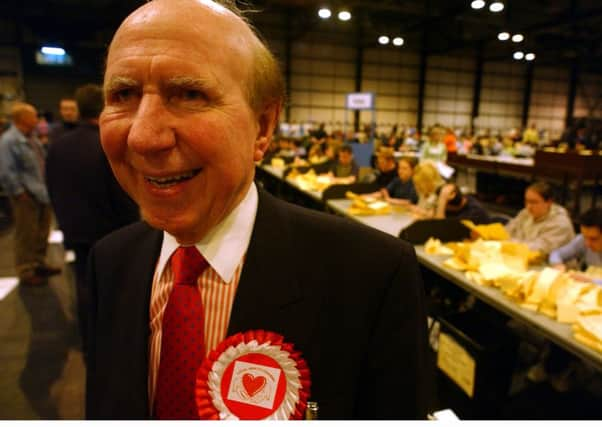Obituary: Pat Lally, politician, provost, council leader, Glasgow's mover and shaker nicknamed '˜Lazarus'


Pat Lally rose from the tough streets of the Gorbals to become Glasgow City Council’s Labour leader and one of Scotland’s highest-profile local politicians who later served as the first Lord Provost of Glasgow from 1996-99.
Nicknamed ‘Lazarus’ for his numerous comebacks, in a career spanning over three decades, he was the ultimate survivor in the uncompromising Machiavellian world of Scottish Labour politics; he was not averse to courting controversy if he felt it was in the people of Glasgow’s best interests.
Advertisement
Hide AdAdvertisement
Hide AdBlessed with a sparkling sense of humour, he was an inspirational and charismatic leader, and enjoyed two spells as Labour leader of the city council, before the local government reorganisation in the 1990s, gaining a reputation for getting things done, his way, and being hugely committed to his home city, although this meant he made enemies – on both sides of the political divide.
Lally was instrumental in promoting Glasgow on the national and international stage too, backing the city’s successful bid to become European City of Culture in 1990, for which locals invented the unofficial motto of “Yer bum’s oot the windae!”
A passionate, determined man, he transformed Glasgow’s image from a city of Dickensian poverty and decline, with huge swathes of city slums without running water and electricity, to that of a cosmopolitan standard-bearer for the arts and humanities, and played an important role in securing the 1988 Garden Festival for the city.
Towards the end of his political life, he was also a leading figure in the provision of city’s Royal Concert Hall, opened in October 1990, a building affectionately dubbed “Lally’s Palais” by Glaswegians, and of the city’s successful bid to be named UK City of Architecture and Design in 1999.
Veteran Labour councillor and former MSP Frank McAveety described him as “one of the most significant figures in Glasgow’s recent history… who had an unwavering and undaunted commitment to his city… and was a champion of the arts and culture, the communities that he represented but above all else he was a champion for the city that he loved.”
Born in Glasgow in 1926, the year of the General Strike, and raised in the Gorbals, which was at the time among the most overcrowded and deprived communities in Europe, Patrick James Lally was the son of Patrick, an Irish immigrant labourer, and Sarah. With a tough upbringing, young Pat left school at 13, initially working in the clothing business until he was called-up for service in the Second World War.
After serving as a radar operator with the RAF, he returned to the rag trade, eventually becoming a director of a chain of men’s outfitters. He joined the Labour party in 1950 when Clement Atlee was at the helm, and by 1966 was elected councillor to the then Glasgow Corporation, becoming its deputy leader in 1972, when Conservative Edward Heath was the incumbent in Downing Street.
In the early 1970s, as tenement demolition was gathering pace in Glasgow he was behind a campaign to provide inside toilets, dubbed “Lally’s lavvies”, for the first time for many blocks.
Advertisement
Hide AdAdvertisement
Hide AdLally then found himself dropped from the Labour’s panel of candidates in 1977 following a row over the allocation of council houses. However, though rarely out of the news, after a spell in the wilderness, he returned to the city chambers three years later, becoming its treasurer in 1984 and ousting fellow Labour councillor Jean McFadden to become leader of the council in 1986; she turned the tables in 1992, but was again replaced by Lally from 1994-96.
Controversy struck again in February 1997, when prompted by an accusation from the then leader of Glasgow City Council, Lally and Alex Mosson, a fellow Labour councillor, were temporarily suspended from the Labour Party after becoming embroiled in a “votes-for-trips” scandal. With the Scottish Labour Party promising to root out sleaze, a one-sided investigation and trial ensued and a campaign of vilification followed in the media, lasting an agonising and bruising 16 months. Both, however, were reinstated after they took the party to the Court of Session in Edinburgh, and Lord Abernethy ordered their reinstatement.
Lally retired from local government in 1999, after completing his term as Lord Provost of the new City Council and left the Labour party in 2003. Remaining in politics, he stood unsuccessfully three times for Holyrood in elections for the Scottish Parliament, the last occasion being in 2007, when he represented the Scottish Senior Citizens’ Unity Party, which he later went on to chair. He subsequently walked away from politics and also finished 37 years as a Glasgow magistrate.
To celebrate his retirement, artist Peter Howson painted two portraits of Lally, one of which raised eyebrows because it omitted his clothes and had him emerging ‘Lazarus-like’ from the grave.
Lally received a number of awards including, curiously, being appointed as a Commander of the Military and Hospitaller Order of Saint Lazarus of Jerusalem (1999), having already been appointed a Deputy Lieutenant for the city in 1986, and admitted to the Order of St John the following year; he was a member of the Glasgow Incorporations of Merchants, Tailors and Gardiners. He was also honoured by China and France, the latter awarding him the Commandeur de l’Ordre national du Mérite.
In 2000, he published his memoirs, entitled, ungrammatically, ‘Lazarus Only Done It Once: The Story of My Lives’ which described his colourful life.
He married Peggy (née McGuire) in 1967, with whom he had two sons, Derek and Robert. She died in May 2007, after losing her battle with cancer. In his final years, he battled dementia. Both sons survive him.
Martin Childs